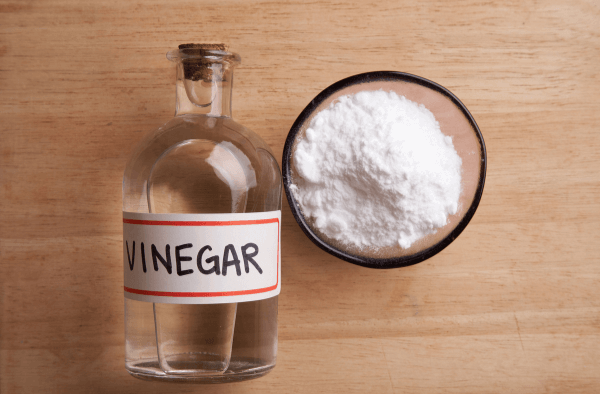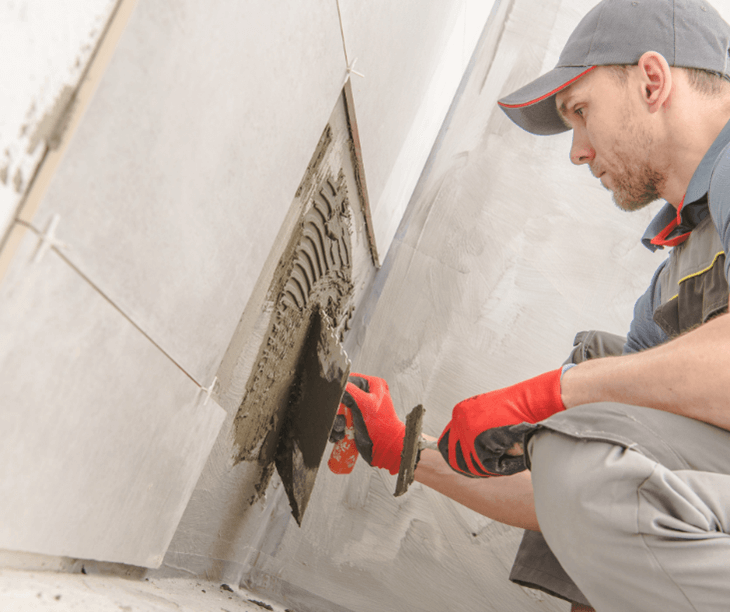Hard water stains are a common problem faced by many homeowners, and they can be difficult to remove without the right tools and techniques. In this article, we will share our expert tips and tricks for removing hard water stains from tiles so that you can keep your home looking clean and beautiful.
Understanding Hard Water Stains on Tiles
Before we dive into the best methods for removing hard water stains, it’s important to understand what they are and how they form. Water spots on tile floors are caused by the buildup of minerals, like calcium and magnesium, which can be found in high concentrations in many water sources. When water evaporates on surfaces like tiles, it can leave behind these mineral deposits, which can be difficult to remove with traditional cleaning methods.
How to Remove Hard Water Stains from Tiles
Fortunately, there are a few simple methods for removing hard water stains from tiles.

- Vinegar and Baking Soda: One of the most effective ways to remove hard water stains from tiles is by using a combination of vinegar and baking soda. Mix equal parts of vinegar and water in a spray bottle, then spray the solution onto the affected tiles. Let the solution sit for a few minutes, then sprinkle baking soda onto the tiles and scrub with a soft-bristled brush. Rinse the tiles with water and dry them with a clean towel.
- Lemon Juice: Another natural remedy for hard water stains is lemon juice. Squeeze fresh lemon juice onto the affected tiles and let it sit for a few minutes. Then, scrub the tiles with a soft-bristled brush and rinse with water. Lemon juice not only removes hard water stains but also leaves a fresh, citrusy scent.
- Commercial Cleaners: If natural remedies don’t work, there are many commercial cleaners available that are specifically designed for removing hard water stains. Look for products that contain phosphoric acid or hydrochloric acid, which can dissolve mineral buildup on tiles. Be sure to follow the instructions on the label carefully and wear gloves and eye protection when using these products.
How to Clean Shower Tiles
Cleaning shower tiles is an important part of maintaining a clean and hygienic bathroom. Here are five steps to help you clean shower tiles effectively:
- Gather your supplies: Before starting the cleaning process, gather the necessary supplies. You will need a mild tile cleaner or a mixture of vinegar and water, a scrub brush or sponge, a grout brush (if applicable), a bucket, and clean water.
- Pre-treat the tiles: If there are any stubborn stains or buildup on the tiles, pre-treat them before scrubbing. Apply the mild tile cleaner directly to the affected areas or spray the vinegar and water mixture. Allow it to sit for a few minutes to loosen the dirt and grime.
- Scrub the tiles: Using a scrub brush or sponge, start scrubbing the tiles in a circular motion. Focus on one small area at a time, applying moderate pressure to remove any soap scum, mold, or mildew. Pay attention to grout lines as well, using a grout brush if needed. Continue working your way across the entire shower surface.
- Rinse the tiles: Once you have scrubbed the tiles thoroughly, rinse them with clean water. You can use a handheld showerhead or a bucket to pour water over the tiles. Make sure to remove all traces of the cleaning solution to prevent any residue buildup.
- Dry and maintain: After rinsing, use a clean towel or a squeegee to dry the tiles and prevent water spots or streaks. Proper ventilation in the bathroom is also essential to prevent mold and mildew growth. Regularly maintain your shower tiles by wiping them down after each use and addressing any stains or buildup promptly.
Remember to always follow the instructions provided with your chosen cleaning products and test them on a small, inconspicuous area of the tiles before applying them to the entire surface.
How to Remove Hard Water Stains from Ceramic Tiles?
Hard water stains on ceramic tiles can be unsightly and difficult to remove. These stains are caused by the buildup of mineral deposits, typically from the use of hard water. Hard water stains on ceramic tiles can be removed using a variety of methods, including vinegar, baking soda, and commercial cleaners, like mentioned before.
How to Clean Porous Tile
The Baking Soda/Peroxide Method is especially suited for cleaning porous tiles like marble, as it doesn’t require the use of any acidic solutions such as vinegar.
To use this method, simply mix one part peroxide with two parts baking soda in an empty spray bottle. Next, spray the solution onto the stained grout and gently scrub the area with a soft brush. It’s important to use a soft brush, especially on porous or marble tile, to avoid scratching the surface.
Another approach is to create a paste by mixing two parts baking soda with one part water. Apply the paste to the stain, allow it to sit overnight, and then scrub the stain with a soft nylon brush. Once you’ve finished, rinse the area with hot water.
But what if my Tiles have Black Stains?
Black stains on bathroom tiles are often caused by the growth of mold or mildew, which can thrive in damp and humid environments like bathrooms, so it’s important to remove them as soon as possible.
How to Remove Black Stains from Bathroom Tiles
To remove most of the mold after water damage from your tiles, you can wipe them with a premade solution consisting of 10% bleach and 90% water. If you’re dealing with tougher stains, consider mixing a solution of 25% bleach and 75% baking soda in a cup. However, before you start cleaning the affected area, it’s important to test the solution on a small section of your ceramic tile to ensure that it doesn’t damage or discolor the surface.
When it comes to mold, it’s best to be safe and contact a mold removal professional if the situation is more serious. A mold remediation service will be able to identify and remove mold in a safe manner, as well as provide advice on preventive measures to avoid its recurrence.
Preventing Hard Water Stains
While it’s important to know how to remove hard water stains, it’s even better to prevent them from forming in the first place. Here are some tips to keep your tiles looking clean and free from mineral buildup:
- Wipe down tiles regularly with a soft cloth or sponge to remove any water or soap residue.
- Use a squeegee or towel to dry tiles after showering or bathing.
- Install a water softener in your home to reduce the amount of mineral buildup in your water.
Will I Need New Tiles after Water Damage?
If your ceramic tiles are severely damaged or have deep-set stains that cannot be removed, it may be necessary to restore or replace them. While minor scratches or chips can often be repaired, more serious damage such as cracks and broke tiles may require replacement.
If you have tried various cleaning methods and the tiles are still discolored or stained, it may be a sign of permanent damage. In such cases, you may need to consider replacing the tiles.
When restoring ceramic tiles, there are a few options. You can either replace the damaged tiles with new ones or refinish the existing ones. Refinishing involves stripping the old finish and applying a new one to give the tiles a fresh, new look.
However, it’s important to keep in mind that tile restoration can be a labor-intensive and costly process. If you are considering restoring or replacing your ceramic tiles, it may be helpful to consult with a restoration professional to get an accurate estimate of the time and cost involved.
Need Help to Restore Water Damaged Tiles?

Hard water stains can be frustrating to deal with, but with the right tools and techniques, they can be removed from tiles. By using natural remedies like vinegar and lemon juice, or commercial cleaners designed for hard water stains, you can keep your tiles looking clean and shiny. Remember to also take steps to prevent hard water stains from forming in the first place! If you are in a situation where these DYI steps aren’t getting the job done, you’ll need to contact a water damage restoration specialist like Jenkins Restorations to assess the water damages and repair or replace your tiles!
